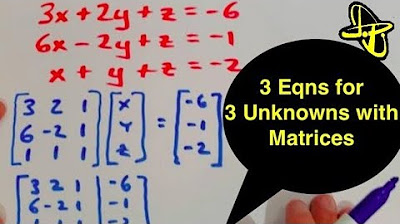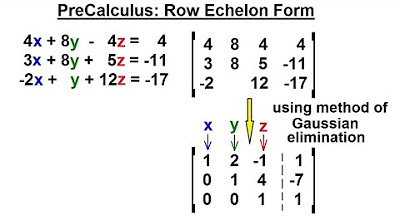7.3.1 Row Echelon Form of Linear Systems of Equations
TLDRThis video delves into solving three-variable linear systems using row echelon form, a method that simplifies equations through a stair-step pattern, gradually eliminating variables. The presenter demonstrates how to arrive at a solution set by working backward, substituting known values to solve for the remaining variables, ultimately yielding the values for x, y, and z in the form of an ordered triple.
Takeaways
- 📚 The video discusses the concept of row echelon form, a method for solving systems of linear equations with three variables.
- 🔍 In row echelon form, the system of equations displays a stair-step pattern, progressively eliminating variables from the highest to the lowest.
- 👉 The top equation in row echelon form contains all three variables, the middle one has two, and the last contains only one variable.
- ✅ The leading coefficient (the coefficient in front of the leading variable) in each row of the row echelon form is always 1.
- 🛠 The process of transforming a system of equations into row echelon form will be covered in later videos.
- 🔥 The video focuses on solving a system already in row echelon form rather than the method of achieving this form.
- 📈 The last equation in row echelon form allows for immediate identification of one variable's value, in this case, Z equals 2.
- 🔄 Utilizing back substitution, the known value of Z is substituted into the equation above it to solve for Y.
- 🔢 Following the back substitution, the values of Y and Z are used to solve for X in the top equation.
- 📝 The final solution is presented as an ordered triple (X, Y, Z), which for the example given is (1, -1, 2).
- 👍 The video concludes with a summary of the values obtained for each variable and reiterates that these form the solution set for the given system of equations.
Q & A
What is the main topic of the video?
-The main topic of the video is about solving a three-variable system of equations using row echelon form.
Why is dealing with three-variable systems trickier than two-variable systems?
-Three-variable systems are trickier because they involve more complexity and require different methods, such as row echelon form, to solve compared to the simpler methods like substitution, graphing, or elimination used for two-variable systems.
What does the term 'row echelon form' refer to in the context of this video?
-In this context, 'row echelon form' refers to a specific arrangement of a system of equations where the system exhibits a stair-step pattern, gradually eliminating variables from the equations as you move down the rows.
What is a characteristic of the leading coefficient in row echelon form?
-In row echelon form, the leading coefficient, which is the number in front of the leading variable in an equation, is always a 1.
How are the two systems of equations presented in the video related?
-The two systems of equations presented in the video are equivalent, meaning they have the same solution set, even though one is in a more simplified row echelon form.
What is the first step in solving a system in row echelon form?
-The first step is to identify the equation with the fewest variables, which in the given example is the last equation, and solve for that variable.
How does the process of back substitution work in solving a system?
-Back substitution involves working your way back up the system of equations, plugging in the values of the variables you've solved for into the equations above to find the remaining variables.
What was the value of Z in the example given in the video?
-In the example, the value of Z was given as 2.
How did the speaker solve for Y using the values from the row echelon form?
-The speaker used the middle equation, which was y + 3*z = 5, and substituted the known value of Z (2) to get y + 6 = 5. By subtracting 6 from both sides, the speaker found y to be -1.
What was the final solution set found in the video?
-The final solution set found was an ordered triple (x, y, z) = (1, -1, 2).
What is the significance of expressing the solution as an ordered triple?
-Expressing the solution as an ordered triple helps to clearly indicate the values of each variable in the system, which is particularly useful when dealing with multi-variable systems.
Outlines
📚 Introduction to Row Echelon Form
This paragraph introduces the concept of row echelon form, a method used for solving systems of linear equations with three variables. It explains that unlike two-variable systems, three-variable systems require additional techniques for solution. The speaker, Mr. Bank, will focus on understanding and solving a system already in row echelon form, highlighting the stair-step pattern and the importance of leading coefficients being ones.
🔍 Solving a System in Row Echelon Form
In this section, the speaker discusses how to solve a system of equations that is already in row echelon form. He explains that by gradually eliminating variables, one can solve for the individual variables. The example provided shows two equivalent systems of equations, with the speaker detailing the process of transforming one system into the other. He emphasizes the importance of back substitution as a technique for solving the system.
📝 Back Substitution and Solution
The speaker demonstrates the process of back substitution to solve the given system of equations. He starts with the simplest equation to find the value of Z, then uses this value to solve for Y in the next equation. With the values of Y and Z known, he proceeds to find the value of X in the top equation. The paragraph concludes with the speaker presenting the solution as an ordered triple (X, Y, Z), which represents the solution set of the system.
Mindmap
Keywords
💡Row Echelon Form
💡Linear System of Equations
💡Substitution
💡Leading Coefficient
💡Back-Substitution
💡Variables
💡Solution Set
💡Ordered Triple
💡Transformation
💡Equivalence
💡Solving Equations
Highlights
Introduction to row echelon form for solving linear systems with three variables.
Explanation that row echelon form involves a stair step pattern to gradually eliminate variables.
Mention that the leading coefficient in front of the leading variable in row echelon form is always 1.
Discussion of two equivalent systems of equations that can be transformed into row echelon form.
Process of solving a system in row echelon form by working backward using substitution.
Solution of the last equation gives Z equals 2, which is part of the solution set.
Using the known Z value to solve for Y in the equation with only Y and Z variables.
Calculation showing Y equals negative 1 after substituting Z and simplifying the equation.
Explanation of using Y and Z values to solve for X in the top equation.
Final calculation leading to X equals 1, completing the solution process.
Presentation of the solution as an ordered triple (X, Y, Z) = (1, -1, 2).
Emphasis on the practical application of row echelon form in solving complex systems of equations.
Introduction to the concept of back substitution as a method for solving systems in row echelon form.
Explanation of how to transform a given system into row echelon form, which will be covered in later videos.
Highlight of the importance of the stair step pattern in row echelon form for systematically solving equations.
Clarification that the goal is to focus on solving a system already in row echelon form, rather than the process of getting there.
Overview of the step-by-step process of back substitution, starting with the simplest equation and working up.
Demonstration of how to perform the back substitution method to find the values of all variables in the system.
Conclusion of the video with a summary of the solution process and encouragement for further learning.
Transcripts
Browse More Related Video

Gauss Jordan Elimination & Reduced Row Echelon Form

Solving 3 Equations for 3 Unknowns Using a Matrix in Row Echelon Form

PreCalculus - Matrices & Matrix Applications (3 of 33) Row Echelon Form

PreCalculus - Matrices & Matrix Applications (5 of 33) Method of Gaussian Elimination: Example

Matrices: Reduced row echelon form 2 | Vectors and spaces | Linear Algebra | Khan Academy

Gaussian Elimination With 4 Variables Using Elementary Row Operations With Matrices
5.0 / 5 (0 votes)
Thanks for rating: